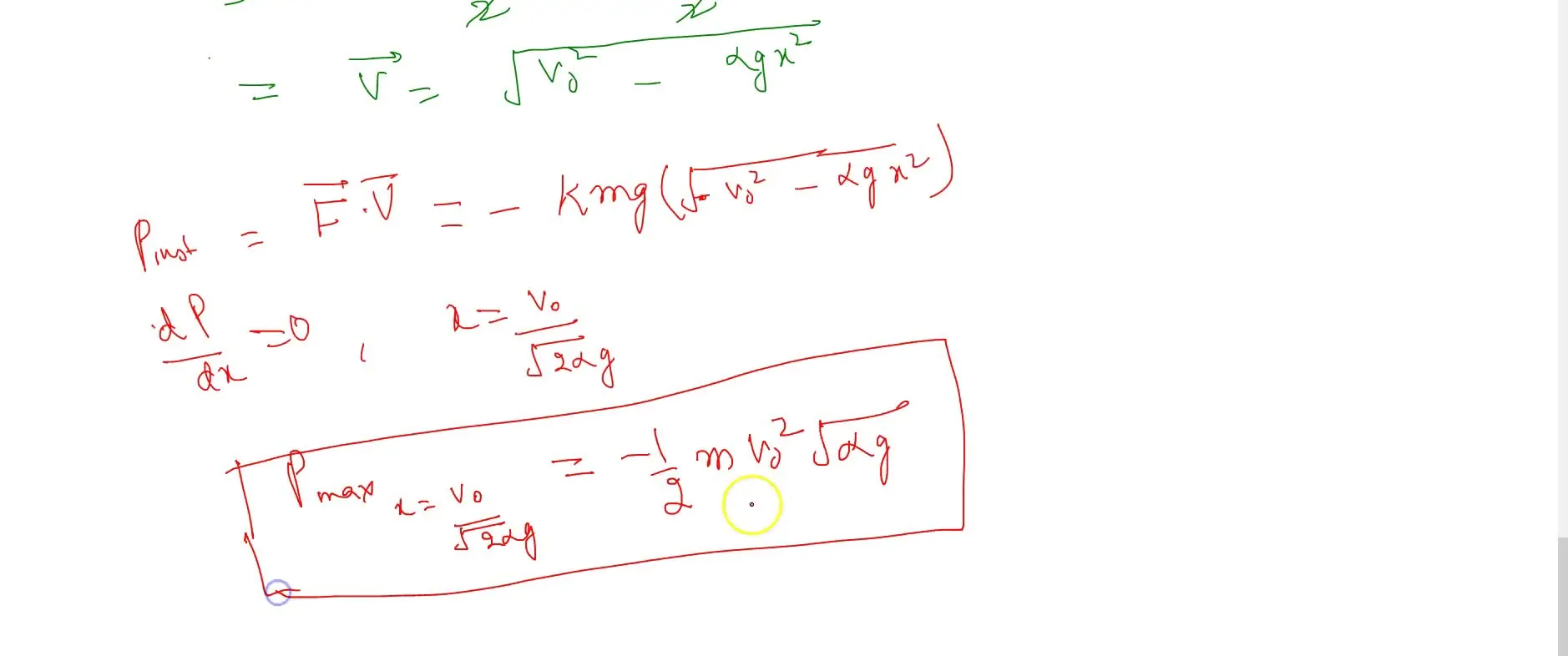A small body of mass m is located on a horizontal plane at the point O. The body of mass m is located on a horizontal plane at the point O. The body acquires a horizontal velocity v0. Find,
(a) the mean power developed by the friction force during the whole time of motion, if the friction coefficient k=0.27, m=1.0kg, and v0=1.5m/s,
(b) the maximum instantaneous power developed by the friction force, if the friction coefficient varies as k=αx, where α is a constant, and x is the distance from the point O.
Let the body m acquire the horizontal velocity v0 along positive x-axis at the point O.
(a) Velocity of the body t seconds after the beginning of the motion,
→v=→v0+→wt=(v0−kgt)→i (1)
Instantaneous power P=→F⋅→v=(−kmg→i)⋅(v0−k>)→i=−kmg(v0−k>)
From Eq. (1), the time of motion τ=v0/kg
Hence sought average power during the time of motion
<P>=τ∫0−kmg(v0−k>)dtτ=−kmgv02=−2W (On substitution)
From Fx=mwx
−kmg=mwx=mwxdvxdx
or, vxdvx=−kgdx=−agxdx
To find v(x), let us integrate the above equation
v∫v0vxdvx=−αgx∫0xdx or, v2=v20−αgx2 (1)
Now, →P=→F⋅→v=−mαxg√v20−αgx2 (2)
For maximum power, ddt(√v20x2−λgx4)=0 which yields x=v0√2αg
Putting this value of x, in Eq. (2) we get,
Pmax=−12mv20√αg
Related Playlists
- BOOK - IE IRODOV, LA SENA & SS KROTOVCHAPTER - PHYSICAL FUNDAMENTALS OF MECHANICSEXERCISE - Universal Gravitation34videos
PHYSICAL FUNDAMENTALS OF MECHANICS
- BOOK - IE IRODOV, LA SENA & SS KROTOVCHAPTER - PHYSICAL FUNDAMENTALS OF MECHANICSEXERCISE - Dynamics Of A Solid Body56videos
PHYSICAL FUNDAMENTALS OF MECHANICS
- BOOK - IE IRODOV, LA SENA & SS KROTOVCHAPTER - PHYSICAL FUNDAMENTALS OF MECHANICSEXERCISE - The Fundamental Equation Of Dynamics59videos
PHYSICAL FUNDAMENTALS OF MECHANICS
- BOOK - IE IRODOV, LA SENA & SS KROTOVCHAPTER - OSCILLATIONS AND WAVESEXERCISE - Electromagnetic Waves, Radiation36videos
OSCILLATIONS AND WAVES
- BOOK - IE IRODOV, LA SENA & SS KROTOVCHAPTER - THERMODYNAMICS AND MOLECULAR PHYSICSEXERCISE - Transport Phenomena38videos
THERMODYNAMICS AND MOLECULAR PHYSICS
Similar Questions
A small body of mass m is located on a horizontal plane at the point O. The body of mass m is located on a horizontal plane at the point O. The body acquires a horizontal velocity v0. Find,
(a) the mean power developed by the friction force during the whole time of motion, if the friction coefficient k=0.27, m=1.0kg, and v0=1.5m/s,
(b) the maximum instantaneous power developed by the friction force, if the friction coefficient varies as k=αx, where α is a constant, and x is the distance from the point O.View SolutionA small body of mass m is located on a horizontal plane at the point O. The body of mass m is located on a horizontal plane at the point O. The body acquires a horizontal velocity v0. Find,
(a) the mean power developed by the friction force during the whole time of motion, if the friction coefficient k=0.27, m=1.0kg, and v0=1.5m/s,
(b) the maximum instantaneous power developed by the friction force, if the friction coefficient varies as k=αx, where α is a constant, and x is the distance from the point O.View SolutionAn object of mass (m) is located on the horizontal plane at the origin O. The body acquires horizontal velocity V. The mean power developed by the frictional force during the whole time of motion is ( μ= frictional coefficient )
View SolutionA small body of mass m lies on a horizontal plane. The body is given a velocity v0, along the plane. (a) Find the mean power developed by the friction during the whole time of motion, if friction coefficient is μ=0.3,m=2.0kg and v0 = 3 m/s. (b) Find the maximum instantaneous power developed by the friction force, if the friction coefficient varies as μ=αx, where α is a constant and x is distance from the starting point
View SolutionA small body of mass m is given velocity v0 at point O on rough horizontal surface. (a) Find the mean power developed by the friction force during the whole time of motion if the friction coefficient is constant and equal to μ0 (b) Find the maximum instantaneous power developed by the friction force, if the friction coefficient varies as μ=μ0x, where μ0 is a constant and x is the distance from the point O.
View SolutionA small body of mass m moving with velocity v0 on rough horizontal surface, finally stops due to friction. Find, the mean power developed by the friction force during the motion of the body, if the frictional coefficient μ=0.27,m=1 kg and v0=1.5ms−1.
View SolutionA body of mass m is thrown at an angle α to the horizontal with the initial velocity v0. Find the mean power developed by gravity over the wholetime of motion of the body, and the instantaneous power of gravity as a function of time.
View SolutionA body of mass m=1kg is thrown at an angle θ=45∘ to the horizontal with the initial velocity u=10m/s. Find the mean power delivered by gravity over the whole time of motion of the body.
View SolutionAn object or mass (m) is located at the origin of a vertical plane. The body is projected at an angle θ with velocity u. The mean power developed by the gravitational force during the interval of time till it reaches maxmum height
View SolutionA body of mass 2 kg is placed on rough horizontal plane. The coefficient of friction between body and plane is 0.2 Then,
 View Solution
View Solution


